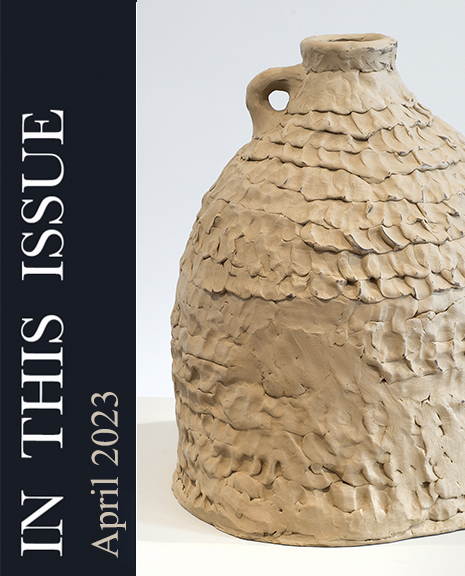 Our common human bond is the Earth. Ideas of care, hope, and action orbit this material and place. How can we build an empathetic relationship with our planet that is intrinsic to our conceptual and physical craft; how can we, through art, instill hope and belief that we can make a difference; how can we create a life that is united with the natural world and not separate from it? These and more are the questions this month's authors grapple with as they invite readers to consider the unique and evolving role we play in the interconnected systems of our Earth.
Our common human bond is the Earth. Ideas of care, hope, and action orbit this material and place. How can we build an empathetic relationship with our planet that is intrinsic to our conceptual and physical craft; how can we, through art, instill hope and belief that we can make a difference; how can we create a life that is united with the natural world and not separate from it? These and more are the questions this month's authors grapple with as they invite readers to consider the unique and evolving role we play in the interconnected systems of our Earth.
Fresh off the heels of the 57th annual National Council on Education for the Ceramic Arts (NCECA) conference, it goes without saying that I would look for the broader conference connections to this month's issue. Inspiration abounds; the rich tapestry of ceramic-related selections exploring the major problems facing our globe was woven into every component of the conference. So, what gem do I report back to you with?
Start where you are.
The gem I was looking for was something that I hoped would be universal, relatable, and something that each of us, regardless of race, gender, or creed, could identify with.
Start where you are.
In the NCECA live podcast event "Taking an Environmental Approach to Making," hosted by Marianne Chénard of the Kiln Sitters podcast, Ben Carter and Julia Galloway shared an exchange that opened with "Start where you are."
Ben Carter: "We don't want this to be a guilt thing. We are not going to try to guilt everyone into changing, but there is something to be said about making the small changes that you can make every day, and those will add up to bigger societal change."
Julia Galloway: "One thing that I just loathe is when I have a problem, or we are discussing a problem, and there is no solution or positive idea around it." Julia continues, "In thinking about studio practices, especially as a teacher... every year at school, we try to address one thing. And honestly, we can do one thing. And now it has been four years, so we have done four things. But we couldn't have done four things in one year. Some [of the environmental approaches] are lowering our firing temperature; another is changing our clay bodies – as much as possible – to be regional materials."
Their exchange looked at the demoralizing statistics that freeze our capacity to make meaningful change and funneled the vastness – the complexity – of the global crisis into, as Julia describes, "little nibbles that add up in a wonderful way."
In this thematic issue that I'm calling "Dear Earth," each author does just that. Studio Potter brings together an astonishing range of artists and activists who share a little piece of where they are regionally, socially, and environmentally. David McMillian explores the framing of the question, "Where are you from?" when he explores regionally specific ceramics. Chenoa Baker asks, "When is a work truly finished?" when exposing the powerful connections between unfired clay and the division of race, labor, and gender. In this month's FREE article, Alexandra Engelfriet speaks about her performative work, on being sucked deep into a mass of clay, "I am going under. I enter into a layer of the earth in which death is revealed." Or is she arising out of it? Keith Luebke takes a sociological look at "How can the chosen path of making pots help us understand how to improve the work lives of others?" and Rachel Marne Jones asks, "What gifts can we give to future generations in times of climate emergency?"
If each Studio Potter reader were to make one small change – social or environmental – we could collectively make 88,331 changes. I welcome you to read this month's issue, and I welcome the little changes that will positively influence the values that orbit our Earth.

Randi O'Brien, editor
